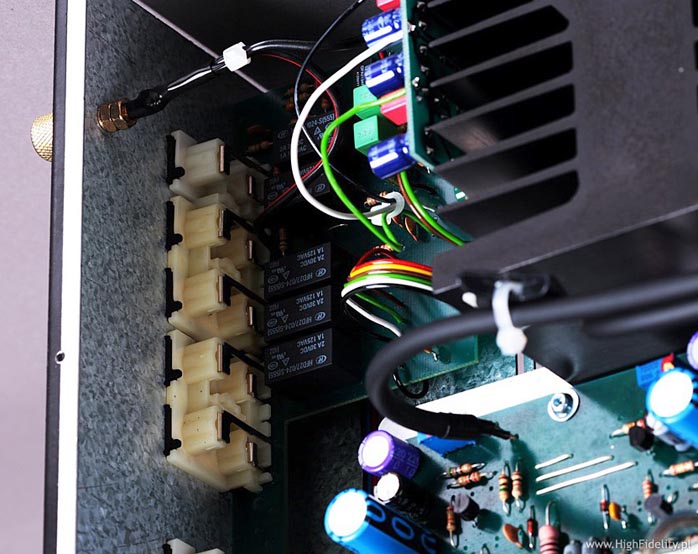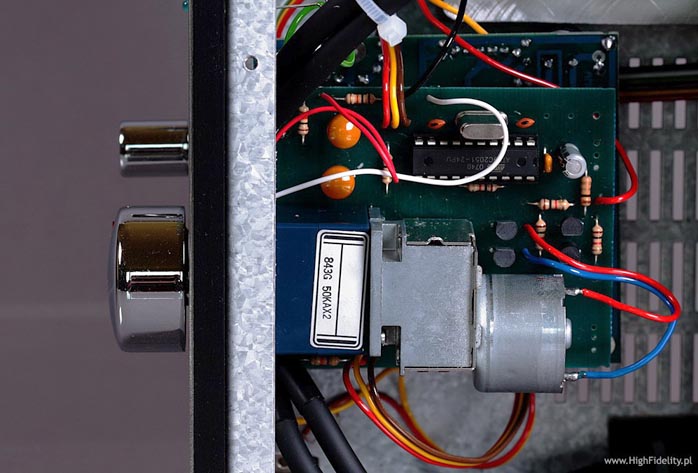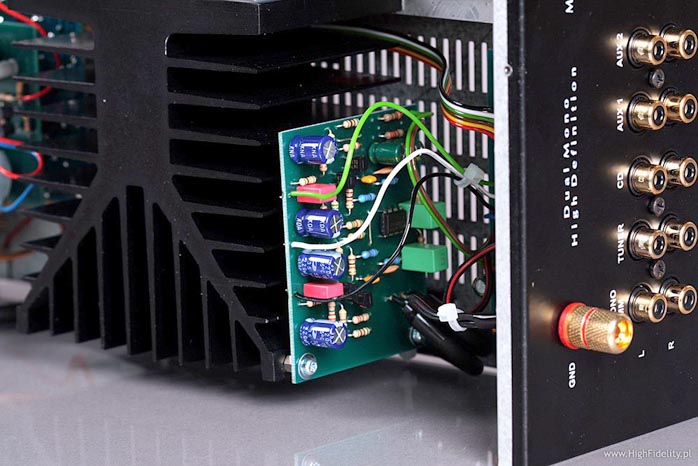This review page is supported in part by the sponsors whose ad banners are displayed below |
 |
 |
Description: The Chopin MkIV from the Struss Amplifiers company is a compact but very heavy device. Although lower than the model 140 (respectively 105W/8Ω vs. 140W/8Ω), its power has more meaning because it almost doubles when impedance halves (195W/4Ω). Listening sessions confirmed how the amplifier has very good dynamics. This aspect was perfected by the company over a long time and resulted in a European patent (RP Zdzisław H-S, PL176514) which describes the symmetrical audio signal processing path.

The enclosure is made from sheet metal, the front from a thick aluminum panel while wooden elements bolt to the cheeks exactly like the model 140 does it and certain Japanese designs by Accuphase or Leben. Their function is primarily aesthetic but they also reduce enclosure vibrations. The front is nicely composed of a chrome-plated steel rhombus placed on a black background. Almost all control functions are placed on that rhombus - a medium-sized volume knob with a red LED showing position, a small knob for the headphone amp volume (sadly without any markings) and the input selector with blue LED indicators. There is also a 6.3mm headphone socket. The power mains switch sits on the other side of the front panel. On the back we get four line inputs all RCA unbalanced; an MM phono input with a ground post and two pairs of gold-plated loudspeaker sockets. Those aren’t of the jewelry kind but appear very solid. However they sit quite close together so I’d recommend banana plugs as the spades could short-circuit.
|
|
|
From the very beginning the company insisted on dual-mono layouts with two power transformers. The Chopin maintains that tradition but we can see certain details not that readily found in more expensive machines. The most important of those are related to mechanical solutions. Below the two large toroidal transformers made to the company's specs by a Danish supplier at 400 watts each, we have a thick copper plate that renders the enclosure more rigid while doubling as a shield. The output stage PCBs too get a nice foundation in the form of a big aluminum slab that is part of the heat sink to which the power transistors are bolted while at the same time fortifying the construction.

The circuitry is divided between a few discrete PCBs. The input sockets are not gold-plated at first sight but Mr. Struss explains that "...the gold-plated RCAs come from the Japanese Yalco company and are imported from the UK. According to the RoHS norm, these are gold-plated on the outside and the solder connectors are lead-free solder with silver which is why they do not look gold plated. These parts are much more expensive than Chinese ones where varnish is called gold."

The input PCB sports hermetic relays. There is a single Burr-Brown OPA2134 operational amplifier that seems to be responsible for the RIAA correction on the MM phono input. Then the signal moves to a small PCB with a symmetrical input on J-FET transistors and a single IC TLE1072. Initially I thought this part of the preamplifier but Mr. Struss corrected me: "This is not a preamplifier. This is a patent-pending inverter built on J-FET transistors to introduce the second harmonic which removes from the amplifier the solid-state dryness'. The TLE1072 is an auxiliary element not in the signal path.” The PCB is bolted to a heat sink, which helps cool the power transformer aluminum plate.

From that PCB we progress via shielded Gotham GAC-1 cables to the motor-driven Alps Blue Velvet potentiometer and then via long leads to the output stage boards. The power transistors are two pairs of HEXFET IRFP240 + IRFP9240 transistors working in push-pull. The entire current buffer is solid state. The signal on the PCB runs on short traces and the circuit is not very complex. The earlier mentioned Jamicon filter capacitors have a total capacity of 88 000μF. The power supply for the preamplifier is taken from one of the power supply channels. Everything looks very solid and although I would change certain items like adopt chassis-bolted RCAs, a better headphone socket—"the socket may not look very pretty but we can give 100 years of warranty on it and use this simple but effective part on purpose" says J. Struss—and shorten the long flying leads, mechanically and electrically this is a very competent design in general. Bigger companies like Primare can build better enclosures but such is the fate of small firms like Struss. Fortunately the sound quality shifts this perspective. The remote control is big and ugly but extremely easy to use with just two buttons: volume up and down. VTL has a similar solution and it is enough though perhaps a mute button would be handy. Let’s add that the amplifier includes 100% protection against short circuits on the outputs and DC protection.

Technical data according to manufacture):
Sinus power: 2x105W/8Ω, 2x195W/4Ω
Music power: 2x125W/8Ω, 2x210W/4Ω
Frequency response:10Hz-150kHz (+/- 0.1dB)
Input sensitivity: 325mV – line inputs (4), 2.5mV phono MM
Input impedance: 100kΩ line, 47kΩ phono
Output impedance: 0.05Ω
THD: <0.1% (1W/8Ω)
Noise on loudspeaker output: max 60μV – wideband measurement
Dynamic range: 130dB
Current output: 50A/1ms
Maximum operating temperature: 50°C |

opinia @ highfidelity.pl
|
|
|
|
 |
 |
|